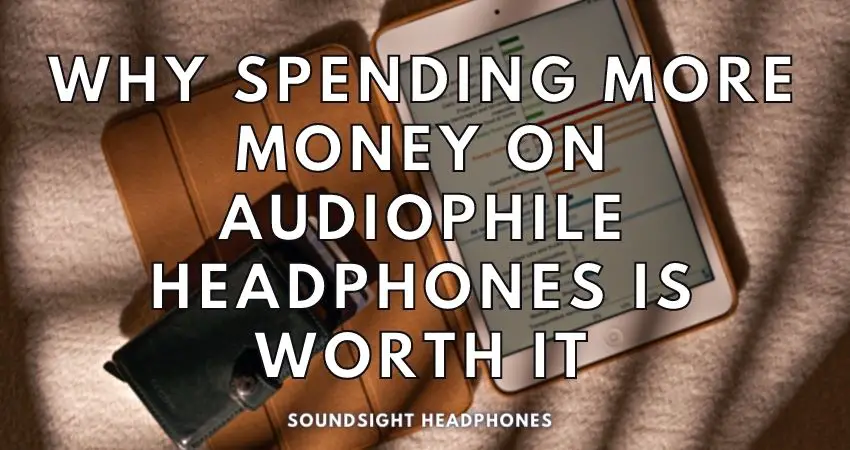Everyone’s looking for ways to spend less for the best-sounding headphones, but few are wilful to pay a premium for quality, high-fidelity headphones. If you have ever pondered spending more money for better sound instead of going the value-for-money route, this article is for you.
Without getting into the question of whether you should buy the most expensive high-fidelity headphones around and whether high-end audiophile headphones are worth it, we’ll only articulate the “Why” in this article. LINK HERE
Why it is justified to pay a tremendous amount of money for audiophile quality headphones:
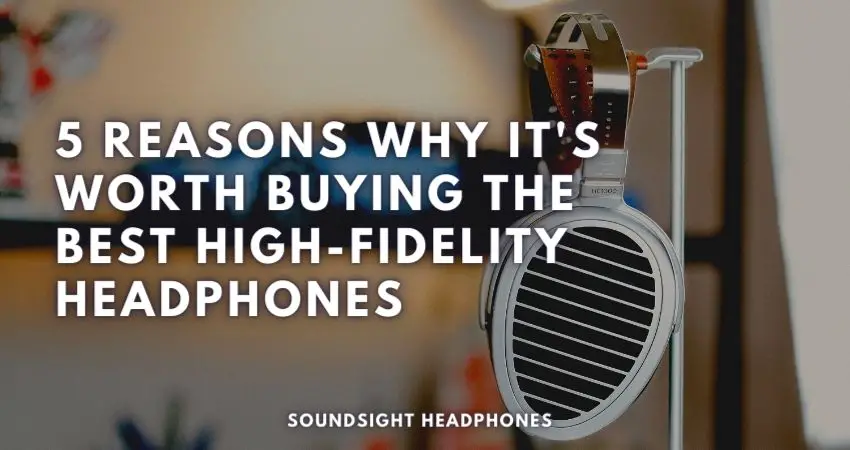
Five reasons why buying the best high-fidelity headphones is worth it
Pricey audiophile-quality headphones are worth considering. The reasons why are expressed by the Hi-Fi community of audiophiles and enthusiasts in their own words:
Unmatched audio quality
There’s no level above high-end hi-fi headphones. You can shell out $500 on the best value set of HiFi headphones and use expensive cables, but if you don’t buy a top-end pair of hi-fi headphones, you are far from an empyrean listening experience.
More often than not, Premium audiophile headphones make your music sound more transparent and remove noise & unwanted effects like hum or background hissing (for example, in less powerful systems). They also reveal an abundance of details that are usually unknown until heard with expensive high-end headphones geared to audiophiles.
Even after significantly upgrading your audio system, a good set of audiophile headphones costing in excess of $1,000 or $2,000 will still improve the quality of your audio experience, which would not be possible if you had to buy value-oriented Hi-Fi headphones.
The technical performance of headphones is just one aspect of their value. It's more important to consider the emotional and sensory impact of listening to music.
Squeeze the most out of your music
A great example of why it’s worth spending a lot of money on the finest high-fidelity headphones is the slight improvement in sound resolution, transparency, detail retrieval, and soundstage by going “high-end” with headphones.
While impressive as is, the Sennheiser HD 660 S Hi-Res audiophile headphones cannot outperform headphones like HD 800 or HD 800 S, but the difference between these headphones allows you to squeeze more juice out of your music and make it more enjoyable.
Still, with all the high-value audiophile headphones you can buy out there, I have rarely had a chance to genuinely experience music in a delectable way with any of them.
With really expensive hi-fi headphones, the details are extraordinary. It’s as if I could hear the sounds zoomed into place around me and the musical notes coming to life.
The truth is that paying more for expensive audiophile headphones yields greater listening pleasure.
Experience a distinctive sound signature that only a rare few Hi-Fi headphone offer
When talking about conspicuous, high-cost headphones, most qualities are maxed out. Everything is offered at a premium level; the only difference lies in the sound signature.
Above $1,000, audiophile headphones offer extreme attention, sharpness, and seamless sound (that’s not the case with many planar headphones that lack dynamics, sound resolution, and sound limp).
This is also the range where, once you’ve established your preferences, you start experimenting with Hi-Fi headphones to find your “end-game” headphone whose sound signature and sonic character fit you.
Some examples of headphones based on the sound signature that impressed us (that also cost a fortune):
Warm/Dark:
- Foster TH900 MK2
- Audeze LCD4
- ZMF Atticus
- Sony Z7
- Sony IER-Z1R
Analytical/Bright:
- Sennheiser HD 800
- HiFiMAN HE1000 V2
- Beyerdynamic Tesla T1
Balanced:
- AKG K812
- Meze Empyrean Elite
- HIFIMAN Arya Stealth Magnet
Besides achieving a top-tier sound that matches your endeared sound signature, another reason that makes spending considerable amounts of money on audiophile headphones is the pleasing look of high-end and luxury headphones.
Polished, well-designed, and finished
For those who don’t lose sight of the goal of “more clarity, better sound” with their high-end audiophile headphones, another key appeal of expensive Hi-Fi headphones is their impressive design, exquisite materials, and finishes.
Every element of a high-end headphone is meticulously crafted, creating a superior look and finish. Of course, this also applies to the construction, which is stronger and more rigid for increased durability.
Finding the headphone that plays just for you
At last, a sense of satisfaction.
The feeling of satisfaction that comes with finding the high-end headphone that strongly fits your core preferences, which is well-made, carefully finished, and gives you a listening experience as unique as if they had been produced entirely for you.
Spending more money on audiophile headphones is hard to explain or put into words, but when buying headphones is more than a hobby – a passion or obsession, it doesn’t matter whether you pay $500 or $5000 to reach the summit.
Of course, this imaginary objective isn’t grounded in the price of the Hi-Fi headphones, but it’s motivated primarily by how you experience and enjoy music with your ears.
It’s a journey unique to you and an enthusiasm that can be fulfilled by exploring the vast range of headphones to acquire enough knowledge about the fundamentals that make music listening enjoyment.
Anyone can chime in and say that a particular headphone is the best, but you should discover if that stands up to scrutiny.
So there you have five reasons you should consider spending a hefty sum of dollars on audiophile headphones.
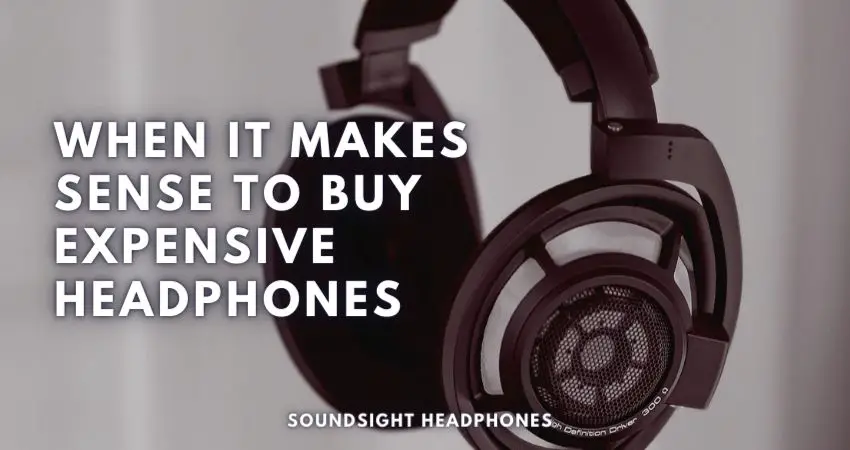
When buying expensive headphones becomes necessary
Increased money spending doesn’t always equal better performance and higher quality. However, audiophile problems can sometimes only be tackled by purchasing an expensive pair of hi-fidelity headphones.
Although the following list is not exhaustive, here are some common scenarios when paying big bucks for high-end headphones is worth it:
The appreciation for music is only achievable with expensive Hi-Fi headphones
There’s hardly a person who wouldn’t rather listen to music through mid-fi headphones the way most music lovers do.
But when you cannot attain that listening pleasure through affordable Hi-Fi headphones, you need to step up and buy a highly regarded pair of audiophile headphones.
Suppose you're an audiophile bent on doing everything right to get that amazing listening experience. In that case, that good pair of high-end audiophile headphones will cost you but will be well worth the money when you connect it to a powerful headphone amplifier.
When tiny details mean the difference between good and great audio reproduction
If noticing even the tiniest details on the music you’re playing makes you love your music the most, then buying expensive audiophile headphones becomes more justified.
For most, small improvements are just that: a small improvement in the quality of their audio experience.
However, if you’re one of those pedantic audiophiles who try to turn every possible ounce of detail into a listening pleasure, high-end Hi-Fi headphones can be that extra push needed to get that better sound you crave.
You have fixed preferences, and no headphone between $0 to $1000 satisfies you
Your desirable headphone has well-defined parameters.
It offers high-fidelity sound transmission, an exquisite design worthy of displaying in your living room, and the sound profile you’ve always asked for.
If the peculiar bass oomph of Fostex TH900 MK2 doesn't satisfy you, or the staggering sound resolution of Sennheiser HD 800, no cheaper headphones will do.
In this scenario, there’s no way you’ll be satisfied with any “still good” sounding headphones. Sometimes, you must spare no expense and get the best.
Whatever it may be, the level of audiophile-grade quality and a sound signature that comes with expensive headphones demonstrates a wise investment and need not be limited to a certain price range.
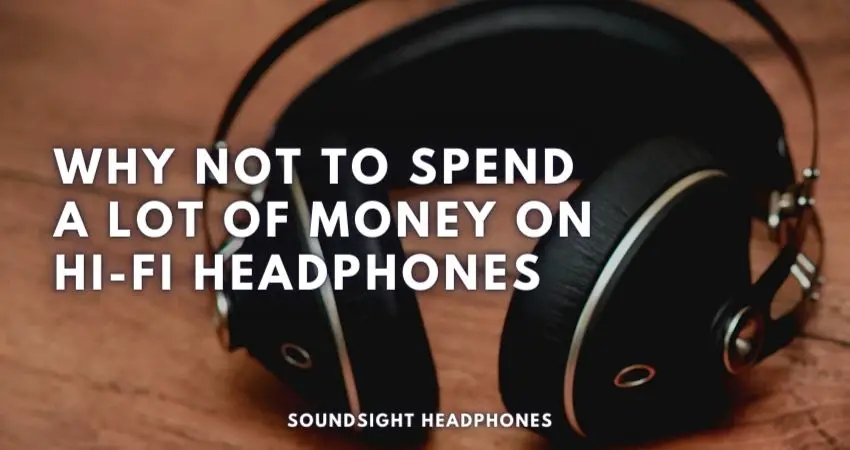
Why You Shouldn’t Spend Too Much on Audiophile Headphones
To cover the other side of the coin, let’s include the reasons why buying expensive headphones might not be a good idea:
Buyer’s remorse is a thing
Buyer’s remorse is a phenomenon in which a buyer experiences regret purchasing a product or service. It can be an emotional response to guilt, anxiety, and disappointment associated with perceived negative aspects of a purchase.
A lack of appreciation for the product instantly gives you buyer’s remorse. If headphones praised to excess like HiFiMAN HE400SE don’t raise the expectation or don’t exceed the performance of cheaper, better-sounding headphones, you develop buyer’s remorse.
Buying newly released audiophile headphones can be risky
Any high-end audiophile headphone price can take a plunge after a few years, particularly if the headphones don’t perform as thoroughly and convincingly as expected.
By the very nature of their pricing, any purchase decisions with expensive high-end headphones can be risky and involve a bit of gambling. This is not expected at the release of a new product since newer models in a line-up of HiFi headphones are expected to have better sound qualities and performance than their predecessors. However, you’ll sometimes fee
But when newly released audiophile headphones lose their luster, prices drop, and you can snatch up a bargain.
For example, audiophiles complain about the sound technicality of the $4500 open-back headphones Audeze LCD-5 compared to LCD-4, which could drop prices down to $4000 sooner or later.
Law of diminishing returns
The law of diminishing returns is real and manifests as the property of a product wherein the incremental or marginal gains on a product’s overall performance become smaller and smaller as the price increases.
Receiving smaller returns the more you invest is a disadvantageous deal for regular consumers, which only headphone enthusiasts and audio purists are happy to take.
Although the law of diminishing returns is proportional to the price, it’s not without exception. On average, expensive headphones sound better than cheap ones.
However, audiophile headphones that are not reasonably priced can be challenged by mid-range headphones.
Unforeseen expenses
Paying top-dollar for high-end headphones offering spectacular sound fidelity may come with an additional cost. If expensive headphones don’t sound good enough, they’re either broken, not to your liking, or require a Hi-Fi amp.
A quality high-fidelity headphone amp that can drive your freshly bought high-end headphones can cost several hundred dollars.
Scenario: You buy a pair of HiFiMAN Susvara with a surprisingly low sensitivity of 83 dB per 1mW of power. The headphones are stunningly well-built - a work of art, but they don't sound as breathtaking as reviews express. They need an amp like the Topping A90 amplifier and Topping D90SE digital-to-analog converter (DAC) to complement the amplifier and extend the dynamic range of your high-end headphones, which adds at least $1000 more to your investment.
Hidden charges like repairs, servicing, and upgrades or replacements can dent your bank account.
For example: A single Focal ear pad costs up to $100. That's just for one piece. Imagine the costs of getting your headphones serviced or replacing a broken headband.
Summary of why you should not buy expensive Hi-Fi headphones
- You don’t know what’s good and better (you haven’t established a reference point to know what price is justifiable)
- Compressed music and Spotify music lose their appeal as they begin to appear faulty
- Law of diminishing returns
- Newer flagship models are less rigorous and performant than previous models (for example, LCD4 and LCD5 in terms of dynamics and technical precision)
- Costly to drive for good sound (Hi-Fi amps/DACs)
You decide what’s worth it and how much you’re willing to pay
Everyone has different needs and expectations from their headphones. Some people might value a particular sound signature more than others, but this can’t be quantified or measured. Buying high-fidelity headphones that appear expensive on the surface isn’t what the average person finds essential. For most, paying up to $2000 is ludicrous.
On the other hand, people for whom price is no object seeking the best-sounding cans that match their high-standard needs find it worthwhile to invest in expensive Hi-Fi headphones.
Expensive headphones are worth it, provided they fill the gap between good sound quality and the best.
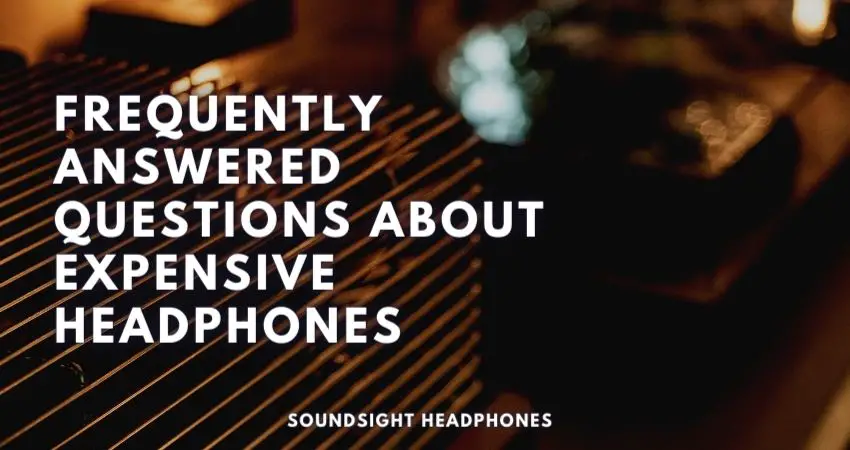
FAQ regarding audiophile headphones and money
Why are good headphones so expensive?
It’s telling that the most expensive headphones on the market are also among the best.
The best products are instantly acclaimed and sought after. In addition, companies ensure that extensive efforts have been put into research, product creation, marketing, and distribution to boost sales of their products.
Money is invested in the betterment of a product, and oftentimes high-priced headphones translate to superior playback.
Although price isn’t the ultimate factor for headphone quality, it’s the most recognizable. LINK HERE
How much should I spend on headphones?
If you’re a newbie seeking advice on how much to spend on headphones, I suggest spending no more than $200 – $300.
Value-wise, spending $300 – $500 for the best sound fidelity is a sound investment. While for audiophiles who don’t mind the diminishing returns past that range, there’s no limit to high-end audio gear.
Should I buy flagship headphones?
Flagship headphones are refined versions of their predecessors, which provide a less faulty performance. Accordingly, it’s worth buying them provided you have enough information about the ins and outs of the headphones from reviewers or first-hand experience to base your decision.
Additionally, the decision-making process for purchasing flagship headphones leans on factors such as:
- The economic value of the headphones
- The direction in which improvements are made
- They’re in line with your expectations
Bottom line
Spending a lot of money on headphones is contingent on how one justifies the high cost of their headphones.
Audiophiles pay big money for high-end headphones because they want:
- The best audio performance there is
- The sound signature and characteristics only found in overpriced headphones
- A finely-built audiophile headphone that doesn’t look cheap
- They have an exclusive interest in finding the one headphone that checks all their boxes
- To experience music in ways they’ve never experienced before
- Last, it’s their only hobby, and they can afford the expenses
If you have disposable income and are delighted by even the tiniest of improvements in your audio listening experience, then, by all means, feel free to splash the cash on premium high-fidelity headphones.
However, the mid-fi market is a great beginning if you want more good-sounding high-fidelity headphones with great value. LINK HERE
